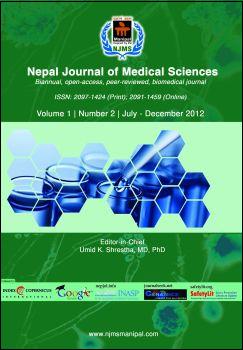Effect of Insulin Resistance on Lipolytic activity of Adipose Tissue in Male Rats
DOI:
https://doi.org/10.3126/njms.v1i2.6602Keywords:
Insulin resistance, adipose tissue, fructose, hypertensionAbstract
Background: The excess usage of fructose as a sweetener has raised the incidence of insulin resistance among the population which is associated with dyslipedemia, hypertension and obesity. This work studied the effect of induced insulin resistance on body weight, blood pressure, lipid profile, glycemic state and lipolytic activity of adipose tissue in male rats.
Methods: Twenty male rats of 129.4 g average body weight (BW) were divided equally into two groups. Both had free access to water. The control group had pure water; the experimental group had water mixed with 25% of fructose to induce insulin resistance. After 3 months body weight, blood pressure, fasting blood glucose, insulin levels, lipid profile of both groups were measured and lipolytic activity of adipose tissue was assessed.
Results: Rats given fructose for 3 months showed significant increase in BW, systolic blood pressure, triglyceride, Cholesterol, low density lipoprotein, fasting blood glucose and insulin levels with a significant decline in highdensity lipoprotein. Lipolytic activity of subcutaneous (SC) and visceral adipose tissue in presence of adrenaline increased significantly which runs in parallel with the results obtained in presence of insulin as it showed a significant rise in both SC and visceral adipose tissue. Data were considered statistically significant at alpha level of 5%.
Conclusion: Insulin resistance induced in male rat by high fructose consumption showed a significant rise in BW and is associated with hypertension and dyslipidemia with significant rise in lipolytic activity of both SC and visceral adipose tissue.
DOI: http://dx.doi.org/10.3126/njms.v1i2.6602
Nepal Journal of Medical Sciences. 2012;1(2): 68-73
Downloads
Downloads
Published
How to Cite
Issue
Section
License
Copyright © by Nepal Journal of Medical Sciences. The ideas and opinions expressed by authors of articles summarized, quoted, or published in full text in this Journal represents only opinions of authors and do not necessarily reflect the official policy of Nepal Journal of Medical Sciences or the institute with which the author(s) is (are) affiliated, unless so specified.




